Hi there, fellow guitar maniacs! A week hardly ever passes without someone asking me, “is a heavier or lighter electric guitar better?” I have to say, most players believe heavier is better, but it isn’t that simple. It depends on many things, like the type of music you play and the nuances of the sound you’re trying to achieve.
Keep reading to learn more!
You can use the table of contents below to take you to the area that interests you. Click on the little box to open it, and then click on the section of the article you want to read, or you can read from start to finish if you want the whole guitar weight experience!
The Short Answer
There is no one best weight for an electric guitar. It all depends on what you value most, tone, sustain, playability, comfort, or cost. The “look (cool factor)” of the guitar should be secondary to all these considerations.
Each player is different, so guitars are available in various weights and styles.
The best way to choose an electric guitar is to play it sitting and standing. If you’re ok with the way it feels, plays, and sounds then that guitar may be a good choice for you.
Keep On Reading (Below) To Learn More
What Determines A Guitar’s Weight?
Any number of factors can determine the weight of a guitar. However, some of the most common things are the type and amount of wood used in making the instrument’s body and neck, the age of the guitar, electronics, and hardware. The guitar’s body type also factors into the weight equation.
Wood Type, Body Type, And Wood Seasoning
Wood and body type primarily determine the overall weight of a guitar, although each individual part adds to a guitar’s weight. It’s important to understand that some woods are denser and, therefore, heavier at the same volume.
Generally, solid body guitars are heaviest, semi-hollow body guitars are lighter, and hollow body guitars are lightest.
Body type can vary widely. For example, a Les Paul guitar is one of the heavier guitars, primarily because it has a thick solid body made from mahogany with a maple cap, both of which are high-density woods. A Strat or Tele has a smaller solid body (usually alder or ash) that is less dense than mahogany and maple.
Wood from various geographic areas and tree species can vary in density. For example, Gibson typically uses Michigan Maple to make its American guitar necks and bodies. However, Michigan has several species of maple, each varying in wood density, like the Red maple (Acer rubrum), Striped maple (pennsylvanicum), and Mountain maple (A. spicatum).
A guitar’s age can also affect its weight. Older wood is drier and lighter than less seasoned wood.
Characterizing Wood By Density
The best way to think about the weight of the wood on a guitar is to understand what density is. The density of any substance is calculated by dividing its mass by its volume (Density = Mass/Volume).
This simply means that a denser chunk of wood of a specific size (height, width, and depth) will weigh more than a less dense piece of wood with the exact dimensions (and vice versa).
As shown in the table below, the wood’s density can vary according to the species of tree and how seasoned and dry it is before the guitar is made.
| Guitar Part (typical use) | Wood Type (seasoned & dry) | Density (Lb/Ft3) |
|---|---|---|
| Body | Basswood | 20-36.8 |
| Body | Alder | 26.2 – 42.5 |
| Body | Ash | 40.6 – 53.1 |
| Body and Neck | Mahogany | 31.2 – 53.1 |
| Neck and Body (cap) | Maple | 38.7 – 46.8 |
| Fingerboard | Pau Ferro | 50.5 – 54 |
| Fingerboard | Rosewood | 51.2 – 56.2 |
| Fingerboard | Ebony | 69.3 – 83 |
For electric guitars, basswood is typically selected as a lighter wood, with alder and ash in between and mahogany and maple on the heavier side.
Guitar bodies are typically made from basswood, alder, ash, mahogany, and maple (cap). In contrast, the necks generally are made from maple or mahogany to help (along with the truss rod) prevent warping.
The guitar neck may be one-piece maple or mahogany. Alternately, it can be maple with a rosewood, ebony, Pau Ferro, or Maple (cap) fingerboard. Ebony is the heaviest tonewood and is typically used on neck fingerboards.
Hardware
A guitar’s hardware can add some weight to the instrument, particularly the tuning machines and bridge, especially if it is a vibrato bridge. Pickguards and other types of control plates can also be grouped in this category.
Electronics
Electronics consist of a guitar’s pickups, wiring, volume and tone controls, and switches. Active electronics add additional pre-amp and equalizer circuitry and a battery.
Approximate Weights Of Popular Electric Guitars
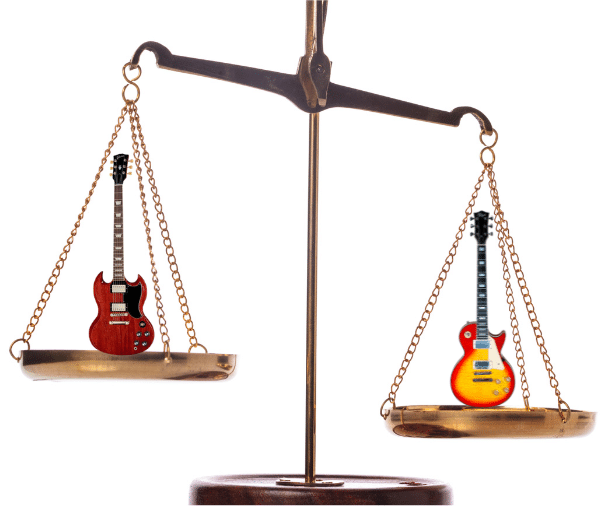
Dan Electro makes some of the lightest guitars on the market, like the ’59 Mod NOS, which is mostly hollow inside.
Generally, Fender Strats and Teles are in the same weight range, while Jazzmasters and Jaguars tend to weigh more.
Gibson electrics run the weight gamut, from SGs being the lightest and Les Pauls being the heaviest.
PRS (Paul Reed Smith) SE Custom 24, Custom 24, and SE Singlecut models weigh approximately the same, while the McCarty Singlecuts are typically a little heavier.
The Ibanez RG series can vary by about 1 pound or more.
Here is a table that shows the approximate weight range of several popular electric guitars.
| Guitar Model | Approximate Weight |
|---|---|
| Danelectro ’59 Mod NOS | 5 to 5.5 Lbs (2.27 to 2.5 Kg) |
| Fender Thinline Telcaster | 6.75 to 7.75 Lbs (3.1 to 3.5 Kg) |
| Fender Stratocaster | 7 to 8 Lbs (3.2 to 3.6 Kg) |
| Fender Telecaster | 7 to 8 Lbs (3.2 to 3.6 Kg) |
| Fender Jazzmaster | 8 to 8.5 Lbs (3.6 to 3.8 Kg) |
| Fender Jaguar | 8 to 9 Lbs (3.2 to 4.1 Kg) |
| Gibson SG | 7 to 7.5 Lbs (3.2 to 3.4 Kg) |
| Gibson ES 335 | 8 to 8.5 Lbs (3.6 to 3.8 Kg) |
| Gibson Les Paul | 9 to 10.75 Lbs (4.1 to 4.9 Kg) |
| PRS SE Custom 24 | 7.5 to 8 Lbs (3.4 to 3.6 Kg) |
| PRS Custom 24 | 7.5 to 8 Lbs (3.4 to 3.6 Kg) |
| PRS SE Singlecut | 7.5 to 8 Lbs (3.4 to 3.6 Kg) |
| PRS MCCarty Singlecut | 8 to 8.5 Lbs (3.6 to 3.8 Kg) |
| Ibanez RG Series | 7.0 to 8 Lbs (3.2 to 3.6 Kg) |
For more info, see Semi Hollow Body Vs Hollow Body Guitars – The Complete Guide.
Things Affected By A Guitar’s Weight

You can click on each of these items to learn more or keep reading the article to find out everything.
Tone – How the guitar sounds before you plug it into an amplifier (acoustically)
Sustain – How long a note sounds before decaying to zero
Playability – How easy or difficult the guitar is to play, lighter is not always easier
Comfort – How comfortable for your body (hands, back, etc.) the guitar is hold
Cost – How expensive the guitar is to make
Keep On Reading (Below) To Learn More About Each Topic
Tone
The weight of a guitar can have a significant effect on its tone. To hear a guitar’s true tone, play it without plugging into your amp. Usually, the heavier the guitar, the more resonant the tone can be.
Don’t forget that the guitar’s wood type also determines the weight and affects tone, which is why it is often referred to as the “tonewood.”
Three Types Of Electric Guitar Body Types
A guitar’s body type not only affects its weight but also affects its tone.
Solid-body guitars have an overall tone that is generally balanced across the frequency spectrum of the instrument.
Semi-hollow body guitars have a small resonant chamber. They can give you an excellent tonal compromise between a solid body and a hollow body guitar.
Hollow body guitars feature the largest resonant chamber. They sound the most like an acoustic guitar with the playability of an electric one. They are the most prone to feedback.
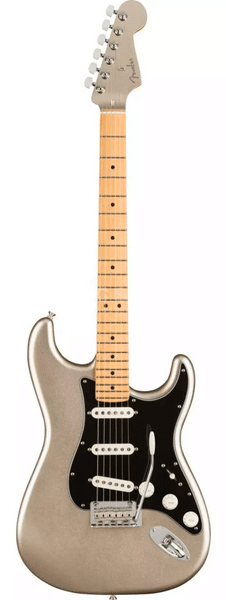
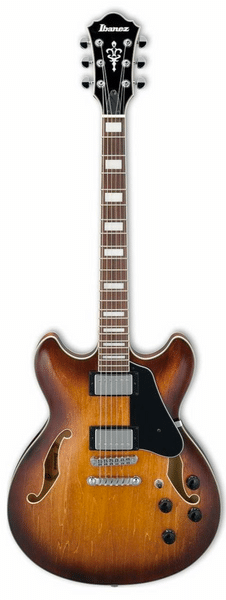

Don’t forget that, even though a guitar’s strings add very little weight, they can profoundly affect tone, depending on the gauge, material, and winding configuration of the string set.
Sustain
Sustain measures how long a note sounds before decaying to zero. Generally speaking, the heavier the guitar, the better the sustain.
Light guitars typically have less sustain but are more comfortable to play sitting and standing.
For example, the Danelectro ’59 Mod NOS guitar has a chambered semi-hollow plywood body with a hardboard top. It is extremely light at a weight of between 5 to 5 ½ pounds! Dan Electro guitars were initially made with a lightweight body material called Masonite.
On the other side of that coin, If I ask you which guitar has the best sustain, you will probably say a Les Paul. It has a thick mahogany body with a maple cap and a glued-in mahogany neck. the design and weight of this guitar make it a “sustain machine!” The trade-off is that the weight of this guitar can make it challenging to play, especially standing up for long periods.
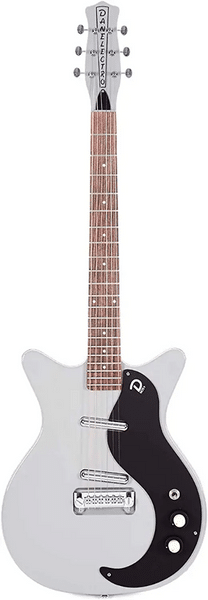
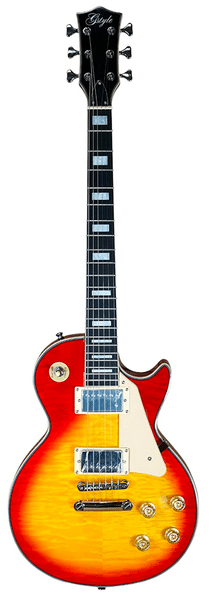
Playability
By “playability,” I mean how you think a particular guitar plays. It’s really a subjective term. The guitar you think plays best might be totally different from what other players think. Sometimes a guitar’s weight can affect how a guitar plays for you. I know players that swear by lighter or heavier guitars.
Also, sometimes a guitar can play better for you by setting it up for your particular needs, like changing the action (string height), string gauge, or tremolo adjustment. So, what you think could be a weight issue might be somewhat correctable by a complete guitar setup. If you don’t know how to do it, take your guitar to a certified technician to avoid damaging your instrument.
A guitar can also become more playable as you continue using it and get used to the best way to pick and finger the strings, adjust the volume and tone controls, etc. As you eventually “wear in” a guitar, the fingerboard edges will become rounder, tonewoods will age, and pickup outputs will change. These can also be perceived in a change in tone and playability.
Neck And Body Size
Neck and body size can affect weight and playability.
Guitar necks on the heavier side can be more challenging to play, particularly if they are “beefy” and you have small hands.
Single-cutaway guitars like the Les Paul can be heavier than double-cutaway guitars like the Gibson SG, and an extra cutaway can make it easier to reach the highest notes.
I think the Gibson SG is one of the easiest guitars to play because of the way its double-cutaways are attached to the lowest part of the guitar neck. It’s also an average-weight guitar, at 7 to 7.5 Lbs; that sounds great!
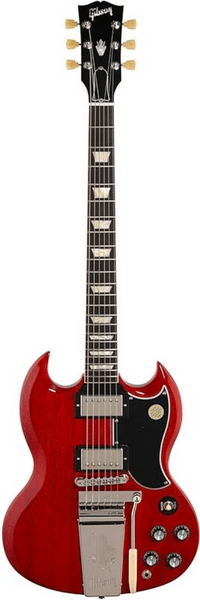

Don’t get me wrong, most electrics on the heavier side, including the Les Paul, play fine! It’s just a matter of what works and sounds best to you.
Weight aside, playability is usually a function of guitar neck size and shape, fingerboard wood and radius, fret size, and body design. These are discussed more in the next section on “comfort.”
Comfort
When it comes to comfort, lighter is usually better. The excess weight of a heavy guitar can be problematic if you play standing for long periods of time. If a guitar is uncomfortable to play or hold, you’re less likely to play it as much.
The average weight of a solid body electric guitar is about 7 to 8 pounds. The hollow body and semi-hollow body guitars are typically lighter. Of course, most Rock and Metal players prefer solid body guitars for their tone, look, and ease of controlling feedback.
A semi-hollowbody guitar can be a good compromise for weight and tone. It’s comfortable to hold and can cover most musical genres, even Rock and Metal. Ted Nugent plays a Gibson Byrdland hollow body guitar and really makes that baby scream!
Guitar body
The Fender Stratocaster is an excellent example of a guitar whose double cutaways and comfort contours in the front and rear make it lighter and shaped for a genuinely delightful playing experience!

The front body contour makes it more comfortable to rest your right forearm on the guitar’s lower bout, and the rear contour (“belly carve”) gives it a nicer fit against your body, especially when playing sitting down.
Guitar Neck
In many ways, your hands do more work fretting notes than plucking the strings, especially if you bend strings or tap strings. Here are the most important things to look for in a comfortable playing neck.
Size And Shape
Different size and shape guitar necks feel different to various players, depending on hand size. Players with average size hands can play just about any guitar. If you have small hands, look for a neck that is less deep from front to back and less wide across the fingerboard. Players with large hands are usually more comfortable with deep, wide necks.
Large bulky maple or mahogany necks will add additional weight to the guitar but can help improve the tone and sustain of the instrument.
Fingerboard Radius
Although this measurement doesn’t really affect the weight of a guitar, it can be an essential measurement for playing comfort.
The fingerboard radius (or fretboard radius) measures how “curved” the wood under the frets is. So, a more curved fingerboard has a smaller radius and vice versa.
An average fingerboard radius for a modern electric guitar is about 9 inches. “Vintage” neck shapes are typically around 7.5 inches. Necks designed to play Rock and Metal are usually flatter, at 12 to 17 inches.


A compound radius neck is more curved at the nut for chord playing comfort and progressively flattens as you move higher up the neck to make string bending easier. For example, it can start at 9 inches at the nut and flatten to 12 inches at the last fret.
Fingerboard Material
Always choose the fingerboard material that plays best and feels most comfortable under your fingers, not the one that looks best.
Maple fingerboards coated with high gloss nitrocellulose lacquer create less finger friction than unfinished fingerboards like rosewood, ebony, and Pau Ferro. However, unfinished fingerboards might feel better to play. It’s really just a personal choice.
Guitar Strap
The right guitar strap can go a long way to improve playing comfort, especially if you perform long stage sets.
Wider guitar straps are usually more comfortable than thinner ones, particularly for heavier guitars like a Les Paul. The strap material can also make a difference. I prefer a soft, pliable, wide leather strap. If you use a single strap, find one that works best with all your guitars.
Adjust your strap length for the best playing comfort, not for looks. Wearing your Les Paul too low to look cool like Jimmy Page probably won’t allow you to play your best and can get uncomfortable quickly! Don’t feel bad; we’ve all tried it, especially if you play a Les Paul!
Cost
Heavier solid-body guitars with thicker bodies or exotic tonewoods can be more costly but not exclusively.
For example, a non-vintage Gibson Les Paul is a great guitar that is fairly expensive and on the heavier side. However, you can pay a lot more for a Paul Reed Smith Private Stock guitar that weighs less but plays and sounds even better.
This PRS Private Stock Custom 24 with a stunning curly maple top, figured mahogany back and neck, and Brazilian rosewood fretboard will set you back at almost $12,000!
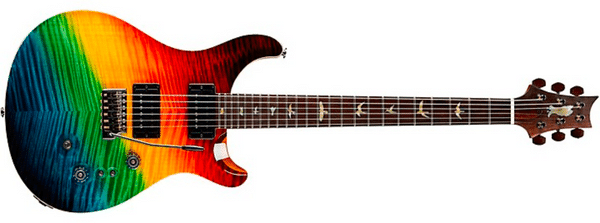
Ok, stop drooling over the guitar and read on! ?
Beware Of Guitars That Are Too Heavy!

Heavy guitars can be great when it comes to playability, tone, and sustain. However, the extra weight can become bothersome if you have problems with your back, hips, or knees, especially if you play standing up.
For extended travel distances, a lighter guitar may be best if you carry your guitar in a gig bag with shoulder straps on your back.
Frequently Asked Questions

Here are some of the questions I get asked about guitar weight.
If your question does not appear here, please put it in the comments, and I will get right back to you with an answer.
Why Are Guitars Different Weights?
The type and amount of wood used to make a guitar determine the majority of its weight. Most electric guitars weigh an average of 7 to 8 pounds, but some guitars are purposely designed to be lighter or heavier. As guitars age over the years, they can lose water and become lighter.
Which Guitar Wood Is The Lightest?
Basswood is the lightest wood that is used to make guitar bodies. It is not well-suited for guitar necks because it is relatively soft compared to other tonewoods.
Which Guitar Wood Is The Heaviest?
Ebony is the heaviest commonly used guitar wood. It is used for neck fingerboards but not to make guitar necks and bodies.
What Is A Good Weight For A Guitar?
There is no best weight for a guitar; it depends on your playing requirements and personal taste. Guitars that are too light may have poor tone and sustain. Heavy guitars may be difficult to play for long periods.
How Do I Balance My Guitar’s Weight?
The best way to balance a guitar’s weight is to position it properly on your lap or with your strap if you play standing. A guitar strap with a “grippy” shoulder material can prevent the guitar from moving while you play.
As a last resort, you can relocate the guitar strap buttons. Always be sure your guitar strap is securely attached to your guitar to prevent “neck dive.”
Final Thoughts

So, is a heavier or lighter electric guitar better? There is no “perfect weight” since every player has different needs regarding tone, sustain, and playability.
The main things determining a guitar’s weight are its wood type, body and neck size, and thickness. Denser woods will make guitars of the same size and thickness weigh more and give them more sustain.
The weight of a guitar can affect its tone, sustain, playability, comfort, and cost.
See Why Is My Guitar Tone So Bad? -Massively Improve Your Sound!, for more info.
Basswood, alder, ash, and mahogany are commonly used to make guitar bodies. Maple is primarily used to make guitar necks and as a cap on the wood of a guitar body, such as a Les Paul (maple on mahogany). Pau Ferro, rosewood, and ebony are primarily used to make guitar necks.
Comfort is one of the primary considerations when buying a guitar. Guitars are often designed to address both comfort and weight. Using the right guitar strap can help improve a guitar’s comfort, especially with heavier guitars.
Heavy guitars can cause or worsen some back, hip, and knee problems if you play standing up for long periods.
Can You Have Your Cake And Eat It Too?
Can a heavy guitar, like a Les Paul, be made lighter and still sound great? Here’s a video from Brian at Musician’s Friend that demonstrates him playing a Gibson Custom Shop limited run 1959 reissue chambered guitar.
It weighs in at just 6.8 pounds and sounds incredible, so check it out!
Admittedly, he is playing through a Friedman amp, but you can really hear the guitar’s tone and sustain come through!

Tell Me What You Think

Please leave a comment below if you enjoyed this article, have any questions about guitar weight, or want to give your point of view. I will be happy to help you.
- Do you prefer playing a lighter or heavier guitar? Why?
- What is your favorite guitar?
- Which guitar(s) do you currently play? Are you happy with its weight?
- After reading this article, are you thinking of switching guitars? Why?
- What else is on your mind?

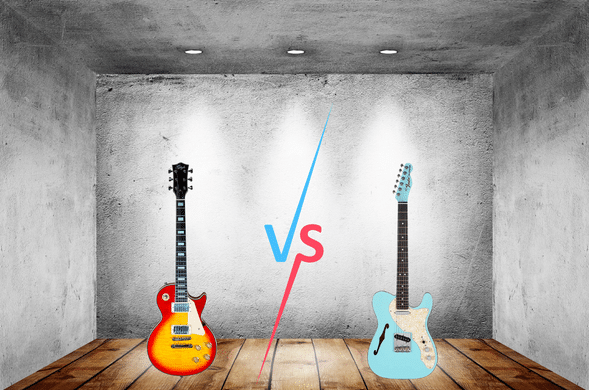

Thank you so much for this post! I love how you made it clear that it comes down to the person’s preference. You’re not trying to let your personal favorite weight to get in the way of helping us chose a good guitar that is right for us. I am also glad that you put the approximate weight of the guitars on the site, because that is something that, well, is not common knowledge. Altogether I think that this is a very thoughtful and informative article and it helps people like me decide what is best for ourself!
Hi Jessie
Thank You for your comments!
It can be tricky to find just the right guitar, not only weight-wise but with the tone, playability, and comfort, you need for the music you play, all inside your budget.
The best approach is to play as many different types of guitars as possible before deciding on the one that’s right for you.
Good Luck & let me know if I can help!
Keep on Rockin’! ?
Frank ?
I am an engineer and I understand strengths on materials but my son who is a guitarist has been on my shoulders requesting for weighty electric guitar. Thank you for highlighting the key differences. Now i have shown him what really matters. The wood quality which will contribute to its density. Once again, Thank you for this in depth look at guitar
Hi, Ayodeji
Thank You for your comments!
Yes, there are many variables that will change the way a guitar plays and sounds, weight certainly being one of them. Most players seek heavier guitars for added sustain and tone.
Wood type and quality can make a big difference.
These days, it’s easy to change or augment the sound of your guitar electronically with devices such as graphic equalizers and compressors.
I hope your son finds the guitar that suits his needs.
Frank
I had a 1976 Les Paul that was very heavy with lots of sustain. It’s like I’m searching, wanting to build a guitar that can give the same sustain from a material or from installing baffles or a mechanism that can simply alter the sound. I wish all guitar builders good luck, we’re always searching for that sound in our minds
Hi, Richard
Thank You for your comments!
Yeah, I love the natural sustain of Les Paul guitars, but they’re heavy, especially when playing long gigs! That’s the tradeoff. Have you tried some of the weight-relieved (chambered) Les Pauls? They sound and play well!
You can always use amp gain to get organic-sounding sustain. Overdrive and distortion pedals work well, and I use a compressor when I really need tons of sustain. I like the optical compressors, like the Aphex “Punch Factory.”
Rock On! ?
Frank ?